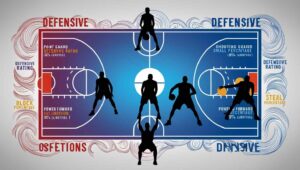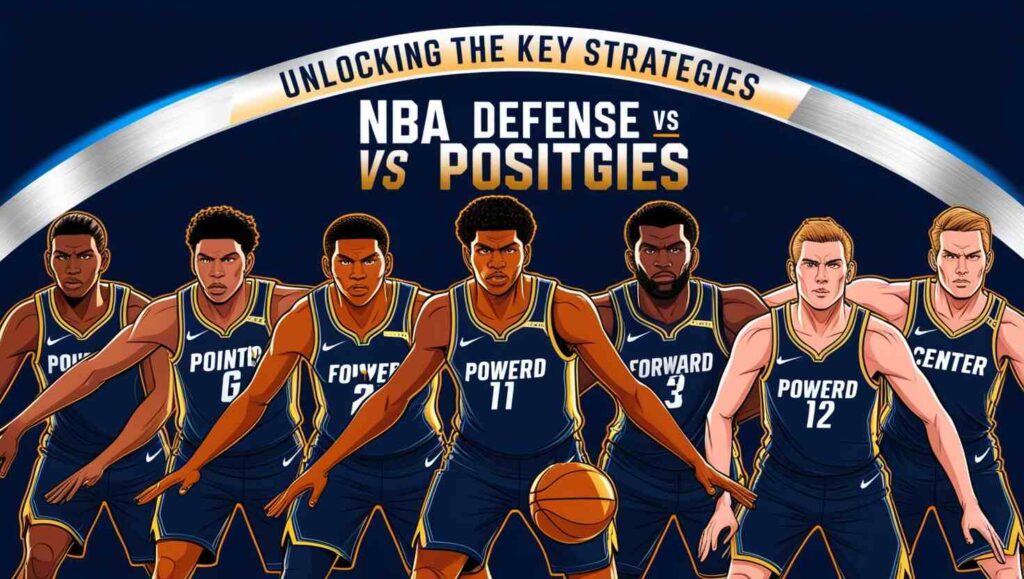NBA Defense vs Position This game in the highly paced world of the NBA makes defense play as significant a part in the unfolding of games and seasons. A great scorer gains most of the attention, whereas a good defensive player wins a championship. What the teams adapt and what different positions the player must adapt plays an important part in NBA defenses. The know-how of defense versus position-DvP-may be super beneficial for all the coaches and analysts, also to fantasy basketball players.
What is defense vs position (DvP)?
Defense vs. position (DvP) is a statistical framework used to determine how well a team defends specific positions on the basketball court: point guards (PG), shooting guards (SG), small forwards (SF), power forwards (PF), and centers (C). The metric gives a sense of how strong or weak a team is against certain roles, providing hints about potential matchup weaknesses and defensive schemes.
For instance, a team with stingy perimeter defenders can overpower guards but can’t match dominant interior big men.
DvP metrics are usually recorded in terms of points, rebounds, assists, and other stats that players are given per game for each spot.
Factors Influencing DvP

Several factors play a role in how teams perform on defense as it relates to a given position:
- Defensive Personnel
Teams with versatile guards such as Draymond Green or Marcus Smart can guard several positions effectively. Their ability to switch screens and anticipate plays really disrupts the flow of the offense.
On the other hand, teams without strong defensive anchors may have problems against skilled players at certain positions.
- Defensive Schemes
Teams have different strategies like zone defense, man-to-man, or switching defense, which influences DvP outcomes.
For instance, a team using drop coverage can give more mid-range shots, which will impact guard and forward stats.
- Matchup Variety
DvP metrics are impacted by injuries, rotations, and matchups. When a team’s starting center is injured, they will not be able to protect the paint effectively, thus impacting the center’s stats of the opposing teams.
- Pace of Play
Teams that play with a faster pace tend to lose more points throughout the board, as they increase the number of possessions. Slow-paced teams offer fewer chances for opponents.
Looking at NBA Defense vs Position Trends
Contemporary NBA changes the traditional game dynamics of defense. It highlights three-pointers, positionless basketball, and fast pace. Let’s check how each of the positions plays in today’s game:
Point Guards (PG)
Point guards are often the primary ball handlers, orchestrating offenses and creating scoring opportunities. Defending against elite point guards like Stephen Curry or Luka Doncic is a significant challenge.
Defensive Strategies Against PGs:
Pick-and-Roll Defense: Many offenses rely on the pick-and-roll defense to free up point guards for scoring or playmaking. Teams with agile guards who can navigate screens, like Jrue Holiday, do well in this area.
Perimeter Containment: Three-point attempts must be limited as modern point guards are often deadly shooters.
Key Stats:
Teams with strong perimeter guards allow fewer points and help opposing point guards.
Shooting Guards (SG)
Shooting guards are often versatile scorers who have the ability to attack the rim or hit three-pointers. Defending players like Devin Booker or Klay Thompson requires a combination of speed, strength, and awareness.
Defensive Strategies Against SGs:
Close Outs: Quick closeouts on three-point shooters force low percentage shots.
Help Defense: Rotation and big man assists can prevent drives to the basket.
Key Stats:
Teams that specialize in transition defense often limit scoring opportunities for shooting guards who thrive on the fast break.
Small Forwards (SF)
Small forwards are the most athletic players on the court and tend to be main scorers or secondary playmakers. They defend stars like LeBron James or Kevin Durant, who are difficult assignments.
Defending Strategies Against SFs:
Physicality: It is tough for physical, athletic defenders to stop the small forward from scoring in the post and from drives.
Switching: The teams with switchable defenders disrupt the small forwards who are strong at isolation plays.
Key Stats:
Small forwards tend to perform only as good as their matchup allows. Players such as Kawhi Leonard, the elite guards, can easily make them almost redundant.
Power Forwards (PF)
Power forwards are big men with size and strength. Today’s power forward, Giannis Antetokounmpo, can space the floor through shooting or take it inside and score.
Defending PFs:
Stretch Defenders: A team with big mobile men who can guard the perimeter and the post.
Rebounding: Keeping power forwards off the glass, and thus limiting their second chance points, is also important.
Key Numbers:
Teams with good rebounding and interior defense tend to restrict the scoring and rebounding for power forwards.
Centers (C)
Big men in the paint are primarily responsible for creating scoring, rebounding, and shot-blocking opportunities. It’s a challenge to defend dominant centers like Joel Embiid or Nikola Jokic because of size, strength, and skill.
Defending Against CS
Post Defense: Good, physical post defenders are key to shutting down shots in the post.
Double Teams: Doubling down on elite centers can be a turnover-inducing or low-percentage shot opportunity.
Key Stats:
Recovery and Rim Protection often correlate with the centers’ success or failure.
DvP in Fantasy Basketball
DvP is a critical tool for making adjustments in fantasy basketball. Identifying which teams have weaknesses at specific positions gives managers an edge in finding ideal matchups.
Tips on using DvP in fantasy:
Target weak defenses: Search for teams that consistently give up big points or stats to a particular position.
Consider injuries: If that team’s key defender is hurt, then players at that particular position will thrive.
Adjust for speed: Fast-pacing games tend to boost the stats of players from all positions involved.
Top Teams and DvP Rankings (2024-25 Season)
Here’s a hypothetical breakdown of some of the top-performing and struggling teams in NBA Defense vs Position:
Best Defensive Teams (2024-25):
Milwaukee Bucks: Giannis Antetokounmpo and Brook Lopez anchor the defense, making the Bucks very strong against forwards and centers.
Boston Celtics: Marcus Smart and Jayson Tatum lead a very versatile defensive unit that is great against guards and wings.
Teams to attack in fantasy:
Charlotte Hornets: The Hornets have historically been weak against centers, giving up a lot of points and rebounds.
Houston Rockets: Young and inexperienced, the Rockets often get torched by scoring guards.
The Evolution of Defense in the NBA
As the game of NBA transforms, its defenses change as well. The use of analytics has made three-point defense and positionless basketball very prominent. The need for versatility is arising, with Mikel Bridges and Bam Adebayo being the examples of this rise.
Future Trends in DvP:
Positionless Basketball: There is less definition in proper positions with the increased reliance on DvP metrics.
Analytics-Based Adjustments: Analytics are increasingly used by teams to identify and bridge the gaps created by positional weaknesses.
End
NBA Defense vs Position (DvP) is a key concept for understanding the nuances of NBA defense. Whether you’re a coach looking to capitalize on matchups, an analyst breaking down game strategies, or a fantasy basketball player looking to improve a lineup, DvP offers valuable insights.
By analyzing factors like defensive personnel, schemes, and current trends, we can get a better grasp of the NBA’s defense intricacies. The game will continue to evolve, so will the strategies and metrics used to test it, ensuring that basketball remains as dynamic and exciting as ever.
Also read How Babar Azam Became the No 1 Cricketer in the World

2 Comments
Nice i really enjoyed reading your blogs. Keep on posting. Thanks
ok bro
thanks for visit my site